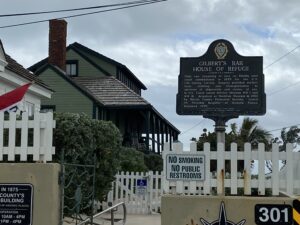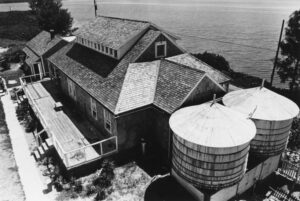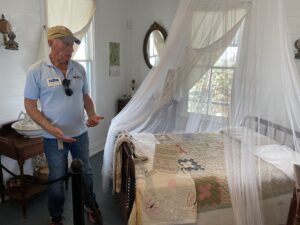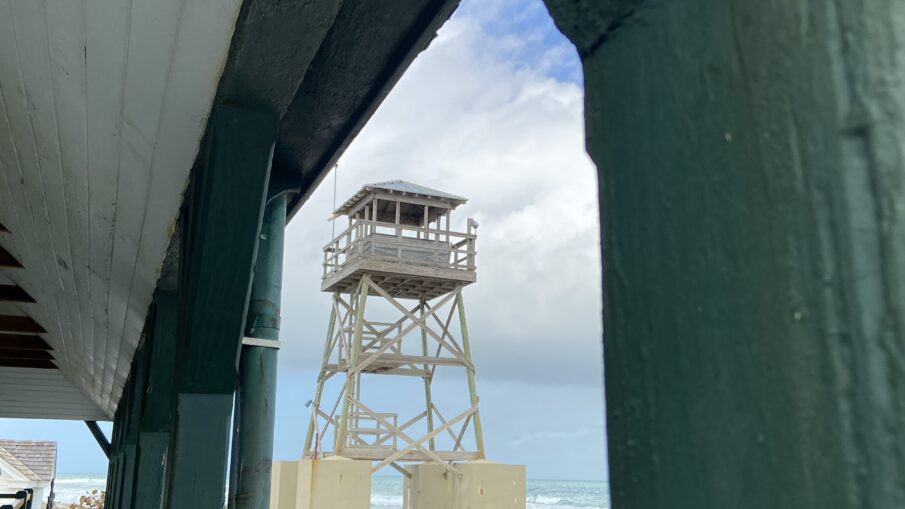Imagine surviving the terror of shipwreck and valiantly washing ashore, only to face near-certain death along a coastline bereft of civilization and fraught with peril.

Hard as it is to imagine, this describes the now densely populated east coast of Florida in the 1800s and early 1900s. Air conditioning had not yet graced the Sunshine State, and few wanted to live there. Railroads had not been extended to Miami and Palm Beach.
Other than some coral formations, the coastline posed few hazards for those floating to shore. But fresh water was scarce. Black bears and panthers patrolled the beaches. Wilting semi-tropical heat and salt-marsh mosquitoes could make even short distances seem endless. Help for those who might be nursing injuries was many days away with no roads or signage to point the way.
This coast has long been a trouble spot for passing ships. In colonial days, a number of treasure-laden ships were caught in storms here. Treasure hunter Mel Fisher made a number of significant finds. To this day, Indian River, St. Lucie and Martin counties are known as Florida’s Treasure Coast.
Centuries later, with international commerce in full swing on the high seas, ships passed the Florida peninsula in ever-increasing numbers. The government needed a system to provide rescue and refuge to survivors. A crew that somehow survived an October 1873 hurricane reported a complete lack of aid upon landing on the Florida coast. Action followed.
In 1874, a series of five rescue stations began to take shape on the coast from present-day Vero Beach to Miami. In the decades to follow, the number expanded to take in the area from Vero Beach to Daytona Beach (Daytona then was the southern fringe of Florida’s settlement). Spaced as evenly apart as topography would allow (roughly 26 miles), these stations became known as Houses of Refuge.
The no-frills government buildings were prefabricated and hauled by ship to the selected locations. One such spot was just north of St. Lucie Inlet, on a narrow strip of barrier island between the Indian River Lagoon and the Atlantic. Named Gilbert’s Bar after a pirate who once terrorized the nearby waters, today this is the only House of Refuge that has survived Florida’s rapid development. Government operations ceased here just after World War II. The statement on a museum display here reads that “the property was abandoned to vandals and to the elements.” It also says Martin County purchased the property in 1953 for the tidy sum of $500. Today it remains a historic site and surprising travel find near the present-day city of Stuart, about 50 miles north of West Palm Beach. A century after Congress voted to build Houses of Refuge, the Gilbert’s Bar site became listed on the National Register of Historic Places. Built in 1876, it is actually Martin County’s oldest building.
Life in Isolation

A guided tour here introduces visitors to life in one of the most unusual areas of public service in its time. To run a House of Refuge, one had to make peace with the fact that they probably would go for stretches of weeks or months without seeing another human being. The U.S. Lifesaving Service, later forming the nucleus of the U.S. Coast Guard, served under the direction of the U.S. Treasury. In its early years, the “keepers” became jacks-of-all-trades, adept with rescues, storm repairs, construction, and marine navigation. They dealt with relentless semi-tropical heat for much of the year, hurricanes, violent thunderstorms, mosquitoes, and even wild animal attacks.
Keepers were allowed to bring their families to the location, a four-room floor plan allowing for a living room, kitchen, dining room and bedroom. Fresh water came from a cistern rigged to isolate water falling from the structure’s roof. From a museum display: “The shingles were new, unseasoned cypress and when we arrived the cistern was full of water from this new roof. It was brown in color, bitter, and with a strong cypress flavor, more like medicine than drinking water.”
The government required keepers to wear a heavy wool coat and tie as uniform of the day. Whoever dreamed up that regulation never spent much time in south Florida. One wonders if, in the absence of observing authorities, the keepers dispensed of that requirement on all but the coolest days.
Far from a glamorous or comfortable assignment, keepers arrived and stayed on the job largely from a sense of duty. They correctly saw themselves on the front lines of life-saving operations. They kept detailed logs of each shipwreck and rescue — logs that are on display today in the museum portion of the facility.
U.S. Navy watches for Nazi Submarines
The Lifesaving Service became the Coast Guard, Florida developed as Henry Flagler extended his railroad southward, and eventually Houses of Refuge became nearly obsolete. In the days just prior to World War II, the Coast Guard transferred responsibility for these properties to the U.S. Navy. What at the time might have seemed like a useless acquisition actually proved quite valuable during the early years of World War II. You see, Nazi submarines were attacking shipping lanes just off the Florida coastline.
A museum display shows the locations of 10 vessels that took Nazi torpedoes in the early years of the war. Most were hit in Atlantic waters north of Jupiter Inlet and south of Fort Pierce Inlet.
Wartime censorship prevented local reporters from writing about the torpedo attacks. But they were known to people who lived in the region. One such attack on February 21, 1942 rattled window panes in nearby Stuart and was felt as far as Okeechobee, some 50 miles away. There were 35 men aboard that ship. Five died, but the others were rescued. A display within the museum section of the House documents these events. It says Ernest Lyons, a local reporter who got out of bed to cover the story that night, was told, “you can’t print one word about this!”
The Navy built the observation tower here that still stands today. What exactly were sailors watching? An account by Max Hunn in the Jacksonville Times-Union (August 23, 1959) says “the station was used as a patrol base against possible enemy agents landing from submarines.”
This is a little-known fragment of our history that people can peruse in an absolutely beautiful, relaxing setting.
Don’t Forget Your Camera

The desolate, remote conditions that prompted construction of Houses of Refuge must be conjured up today with healthy doses of imagination. On your drive to the House of Refuge, you’ll pass several upscale, fully equipped and sprawling resorts with four-star restaurants, challenging golf courses, yachting, and anything else you might require to enjoy a tropical vacation. The Martin County coast is an interesting diversion from the rest of south Florida, where high-rise condominiums and hotels dot the skyline. Here, there is no such skyline. Building heights were capped generations ago, and the current 40-foot restriction invites multiple lawsuits from developers wanting to break the height limit.
Promoters of the rule point to what they call the “Martin County difference,” allowing beach visits that are more in keeping with a bygone era. Fewer people. More space. Preservation of one of the world’s primary sea turtle nesting areas.
Local groups run summertime nesting expeditions in which you can watch the turtles lay their eggs, and make their way back into the water. In fact, at one time the House of Refuge property included a sea turtle hatchery, where the hatchlings lived for six to twelve months and then entered the water with an enhanced chance of survival. Under the direction of sea turtle conservationist Ross Witham, the place attracted dozens of school groups. Visitors of all ages still arrive here to learn more about a largely unknown story in American history.
The House of Refuge is a partner institution of the nearby Elliott Museum, which specializes in Treasure Coast memorabilia. Its holdings include a classic car collection and an extensive display of baseball memorabilia. Check the Historical Society of Martin County website for buying combo admissions at reduced prices.
A team of well-informed docents provides guided tours of the house for a nominal fee. Schedule your visit around the tours. They’re worth the wait.
The building has survived a number of hurricanes, including Frances and Jeanne in 2004. It is a sturdy, little-known reminder of resourcefulness and compassion for those in dire straits.
If You Go

